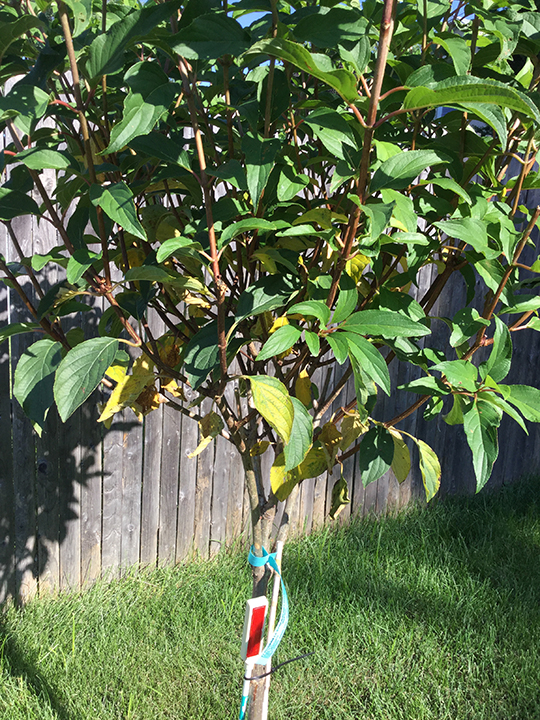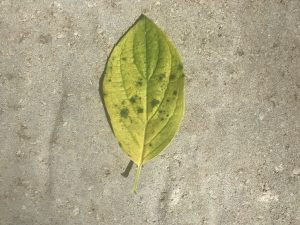How Hydrangea Leaves Turning Yellow can Save You Time, Stress, and Money.
Wiki Article
The Best Strategy To Use For Hydrangea Leaves Turning Yellow
Table of ContentsSome Known Details About Hydrangea Leaves Turning Yellow Facts About Hydrangea Leaves Turning Yellow RevealedNot known Factual Statements About Hydrangea Leaves Turning Yellow Top Guidelines Of Hydrangea Leaves Turning Yellow
Large fallen leaves usually look saggy throughout the mid-day warm. When they fall short to perk up in the evening or still look shrivelled in the morning, your plant could be overwatered.Remove the plant from the soil and prune out any kind of origins that aren't white and swollen (plump). Replant in a brand-new location or work some sand right into the dirt for better drainage. Underwatering also creates entrusts to turn yellow with brown, crispy edges. Do not try to correct the problem by sprinkling exceedingly.
Add a little bit of distilled water, mix the components, and drain the additional water. Put a p, H testing strip in and wait for a reading.
Sphagnum moss or peat moss protects against the dirt from condensing and betters soil drainage while likewise elevating the soil's level of acidity. You can scatter sulfur chips in your hydrangea soil.
Getting My Hydrangea Leaves Turning Yellow To Work
This is one excellent reason to repot houseplants consistently (though there are others, such as origin growth as an example). It is likewise why houseplants require a much more stringent feeding regular than most exterior plants. When a hydrangea houseplant is deficient in nutrients, its leaves will be the very first to reveal the indicators.
Many fluid fertilizer requires dilution with water to reduce the focus somewhat. You will certainly also need to fertilize the plant manually and regular intervals. When springtime starts in March, it's the energetic expanding period for lots of houseplants, consisting of hydrangeas. At this factor, you must start your feeding regimen. Apply fluid fertilizer to your hydrangea due to the fact that this things, as I discussed previously, is fast-releasing.
The dripline is the area situated under the foliage that is the furthest far from the center of the plant. Rather than using feed to the facility of the plant it is best to concentrate it mainly in the external locations of the pot. If you prefer to make use of a slow-release plant food such as granular or spike fertilizer, then cover either type with some soil after you insert them.
The Best Strategy To Use For Hydrangea Leaves Turning Yellow

Although the hydrangea is remarkably frost-resistant, once temperature levels start getting involved in the 20s, the plant is in major risk. If the temps are in the reduced 10s, that threat is extra extreme still. Clearly this is even more of a worry about outdoor plants so if you keep potted hydrangea outside you should bring them inside your home in really winter conditions and even take into consideration moving them inside throughout of the winter season.

A dried hydrangea, A huge trouble with many houseplants is origin rot. Root rot happens when you overwater a plant and because it is such an usual trouble (specifically with succulents) several houseplant proprietors are scared of overwatering why not find out more their plants. Hydrangeas require even more watering that the majority of other common houseplants and can end up being dehydrated when they are underwatered.
The 30-Second Trick For Hydrangea Leaves Turning Yellow
They require massive quantities of water, yet they additionally hate to expand in standing water or water soaked dirt. Be definitely sure that your hydrangea is dehydrated as a result of a lack of water and not because of it be provided way too much water (more on this later). Understand prior to you get that watering can that an overwatered hydrangea presents the very same symptoms as an underwatered one! Overwatering is a serious trouble if you skimp on its water requirements even a little bit, your hydrangea will be quick to show it.The very best method to establish if your hydrangea is underwater is to inspect the wetness degrees in the dirt. By utilizing a reliable but economical dampness and p, H tester, or by sticking your finger into the soil, you will rapidly inform if the plant requires water. To obtain your hydrangea sprinkling practices on the ideal track, you require to be mindful regarding the wetness levels in its soil.
When you remove your finger from damp dirt it will certainly have little amounts of dirt deposit adhered click this link to it. Dry soil will indicate your finger appears clean or with dry soil that is conveniently surprised. If it's damp, and the plant has yellow fallen leaves then the plant has likely been overwatered and you will certainly require to follow the recommendations given in the section below.
Report this wiki page